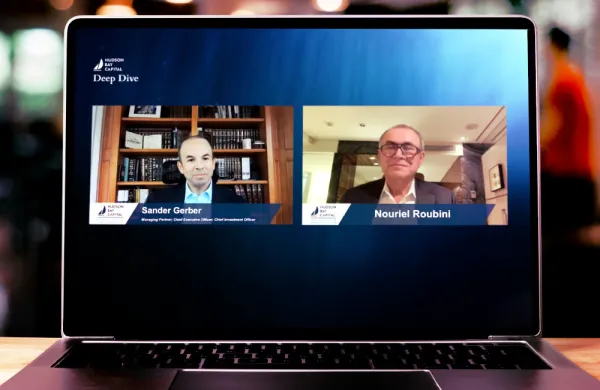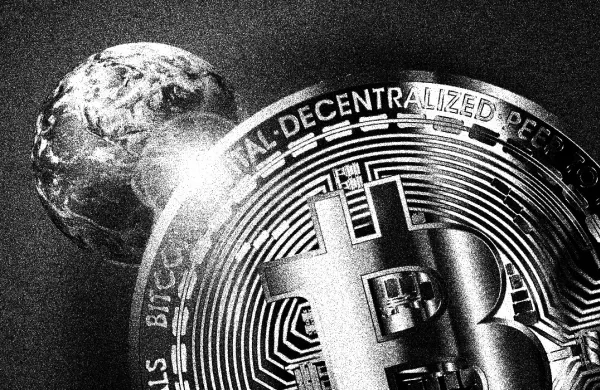
Illustration by Jeremy Leung/II
By now, you’ve read about the co-founder of QuadrigaCX, Canada’s largest cryptocurrency exchange, who died in India and took with him the keys to unlock C$190 million ($144 million) in his customers’ Bitcoin, Ether, and other digital currencies.
But, dear reader, don’t think this is another reductive Nouriel Roubini–type crypto grave dance. No, this tale of “boy meets girl; boy marries girl; boy stores all client cryptocurrency data on cold wallets with no backup; boy dies; more than 115,000 people get screwed out of their precious crypto” could have a happy ending for a progressive asset allocator.
But first, the QuadrigaCX story.
It appears QuadrigaCX co-founder and CEO Gerald Cotten died in India on December 9 from complications from Crohn’s disease. I say “appears” because conspiracy theories are flying around the web and Reddit, spurred on by such facts as Cotten's signing a new will less than two weeks before his death.
According to Bloomberg, “Cotten was always conscious about security — the laptop, email addresses, and messaging system he used to run the five-year-old business were encrypted, according to an affidavit from his widow . . . . He took sole responsibility for the handling of funds and coins and the banking and accounting side of the business and, to avoid being hacked, moved the ‘majority’ of digital coins into cold storage.” (Cold storage, aka cold wallets, is a security technique that generates and stores a cryptocurrency’s private keys in an offline environment, like on paper or a USB drive.)
His security measures were admirable given that digital currency exchanges suffered at least five major attacks last year.
Cotten’s wife and now executor to his estate, Jennifer Robertson, reported (and the QuadrigaCX website confirms) that she has been unable to find passwords or any business records for Quadriga accounts; experts hired to try to hack into Cotten’s other computers and mobile phone had only "limited success,” she said in a court filing. Without the digital keys, clients cannot access their personal digital wallets, effectively stranding their cryptocurrencies. At the time of this writing, QuadrigaCX had been granted an order for creditor protection in Nova Scotia Supreme Court.
In a Twitter post, the CEO of another cryptocurrency exchange described the QuadrigaCX situation as “a bizarre and, frankly, unbelievable story.”
But I find the story neither bizarre nor unbelievable. Signs of trouble had been evident for years.
For example, when QuadrigaCX became Canada’s largest digital exchange in 2015, it stopped publishing financial audits. Around the same time, three of its directors and its chief financial officer resigned. Also in 2015, QuadrigaCX announced a planned reverse initial public offering, but that was later scuttled because the corporation failed to provide the required financial audit. In June 2017, Quadriga announced that it had lost $14 million worth of Ethereum due to a software glitch.
But these are only sideshows to a much darker affair: At the time of his death, Cotten was the sole officer and director at QuadrigaCX. His co-founder, Michael Patryn, had apparently left the company sometime in early 2016, but his resignation was never officially announced.
Maybe it was not announced because, according to news reports, “Michael Patryn” is an alias for Omar Dhanani — the same Omar Dhanani convicted in U.S. federal court in November 2005 for administering and operating “the ‘Shadowcrew.com’ website, one of the largest online centers for trafficking in stolen credit and bank card numbers and identity information.” It is also the same Omar Dhanani who, in 2013, was charged by Montreal authorities as “the alleged ring leader of an online criminal organization which laundered millions of dollars over a five-year period.”
However, out of this apparent tragedy and administrative dumpster fire arises a unique opportunity for a forward-thinking asset allocator: The chance to add an amalgam of cryptocurrencies to the portfolio at what should be a steep discount to face value.
An asset allocator that is at least marginally bullish that crypto prices will increase and/or that technology will improve to the point where it will be able to crack the encryption of the cold wallets could find this opportunity quite attractive.
The best scenario for such a deep-value play, of course, is the assets are unlocked and cryptos increase in value, providing a windfall that is then managed like other liquid assets.
A less bullish scenario would be that the assets remain stranded but the cryptos appreciate, increasing the portfolio’s mark-to-market value and perhaps generating offers from the secondary market to buy the portfolio.
Then there is the reverse situation, where the wallets are unlocked but the digital currencies remain underwater, presenting the owner with the traditional sell/hold decision.
Of course, the assets could remain forever stranded and cryptos could go to zero, resulting in the loss of the entire investment (unless it were hedged with listed and OTC crypto derivatives).
Now, on to the objections.
“The security used to encrypt the clients’ cold wallets is impenetrable.”
This investment is likely measured in decades, not days (which is why the natural buyer is an asset allocator, not a hedge fund or private equity manager). It seems highly likely that sometime in the next 25 years, technology and computer power will evolve to the point where they will be able to overpower today’s best defenses. (And anticipating another problem, the successful hack of an individual wallet is not the same as a hack of a cryptocurrency.)
“An asset allocator lacks the technical ability to hack the wallets.”
Correct, but there is a solution: Mimic Netflix and offer a prize — maybe a percentage of the value of the wallets — to white-hat hackers who can break into the cold wallets.
“What if Cotten is alive, has stolen client funds, and is on the lam in South America?”
Fraud remains a real possibility. As this article was published, QuadrigaCX’s monitor, Ernst and Young, identified deliberate, questionable activity in six cold wallets. Yet, Zerononcense, a crypto research and consulting business, claimed to have found over $100 million in QuidrigaCX Ethereum. Buyer beware.
“How can I know with certainty the current composition and value of the currencies in the wallets?”
“What if a new type of digital asset replaced Bitcoin, Ethereum, Litecoin, etc.?”
Yada yada. Investors raising these and dozens of other objections will not be the buyers of cold wallets.
That investor will see the opportunity for what it is — a purchase of distressed assets (namely the cold wallets) — and will identify and measure the associated risks, structure the deal to mitigate the risks (e.g., adding a claw back covenant to protect from fraud) and price an offer that reflects these risks, which I assume will be a fraction of the portfolio’s face value.
So to that adventuresome asset allocator that has grown weary of almond farms and small-market Indian credit deals, the Canadian Broadcasting Corporation reports that QuadrigaCX’s lawyers are standing by to take your call.





